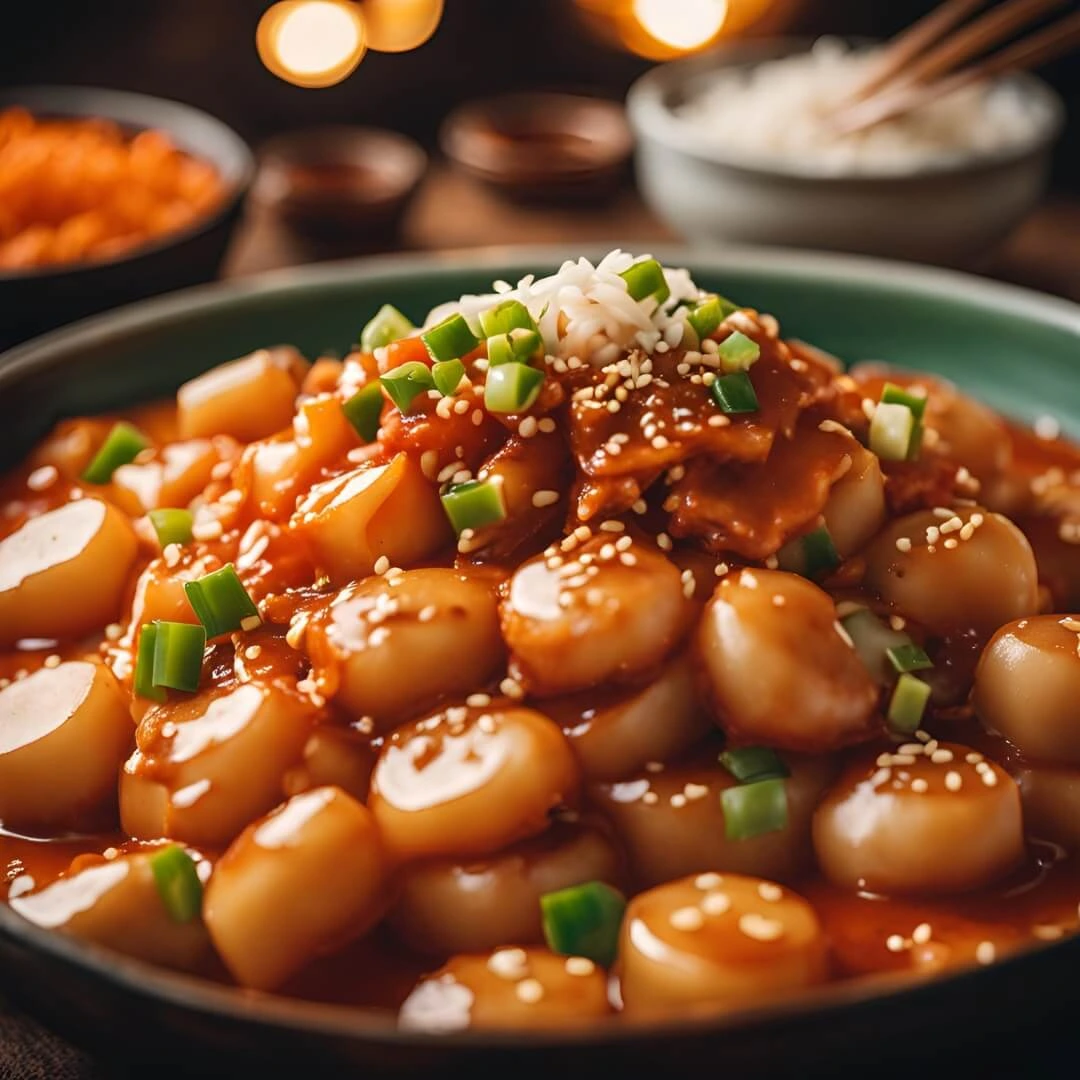Craving spicy and chewy goodness? Learn how to make Korean-Tteokbokki Rice Cakes in just 3 easy steps. Discover now!
Introduction:
Have you ever wondered how those chewy, spicy, and irresistibly addictive Korean street food snacks are made? Meet Korean-Tteokbokki Rice Cakes , a dish so simple yet packed with bold flavors that it’s become a global sensation. Sound too good to be true? It’s not! With just three easy steps, you can recreate this iconic treat right at home. Need proof? Check out this step-by-step guide and discover why tteokbokki is a must-try for spice lovers everywhere. So, are you ready to bring the vibrant streets of Korea into your kitchen?
Overview:
What makes Korean-Tteokbokki Rice Cakes so special? This dish combines soft, chewy rice cakes (tteok) with a rich, spicy-sweet gochujang-based sauce that coats each piece perfectly. It’s comfort food at its finest—simple, satisfying, and endlessly customizable.
This recipe takes about 20-25 minutes from start to finish, making it perfect for quick weeknight dinners or impromptu snack sessions. Plus, it’s surprisingly beginner-friendly—you don’t need any fancy equipment or advanced techniques to pull it off. For more information on the health benefits of fermented foods like gochujang, explore this resource by Healthline .
Even if you’re new to Korean cooking, Korean-Tteokbokki Rice Cakes promises to deliver big flavor without the hassle.
Essential Ingredients:
Here’s what you’ll need to create this flavorful dish. Don’t worry if you don’t have everything—we’ve included substitutions and variations!

For the Tteokbokki:
- Rice Cakes (Tteok): Cylinder-shaped or block-style rice cakes work best.
- Substitution: Use frozen mozzarella sticks wrapped in seaweed for a fun twist (though not traditional).
- Gochujang Sauce: A staple Korean chili paste that provides heat and umami.
- Alternative: Mix ketchup, Sriracha, and soy sauce for a homemade substitute.
- Soy Sauce: Adds depth and saltiness.
- Tip: Use low-sodium soy sauce for a healthier option.
- Sugar or Honey: Balances the spiciness with sweetness.
- Adjustment: Start with less sugar if you prefer milder sweetness.
- Fish Cake (Optional): Adds extra texture and flavor.
- Vegetarian Option: Replace fish cake with tofu or omit entirely.
Optional Additions:
- Eggs: Stir-fried or boiled eggs make a great topping.
- Seaweed Snacks: Crumble over the top for added crunch and flavor.
Step-by-Step Instructions:
Follow these detailed steps to prepare your Korean-Tteokbokki Rice Cakes .
| Step | Instructions | Tips & Techniques |
|---|---|---|
| Prepare the Sauce | 1. In a bowl, whisk together gochujang, soy sauce, sugar, and water until smooth. 2. Adjust the ratio of ingredients based on desired spiciness and sweetness. 3. Set aside while preparing the rice cakes. | – Taste the sauce before adding it to the pot to ensure balance. – Use chicken broth instead of water for added richness. |
| Cook the Rice Cakes | 1. Heat the prepared sauce in a large skillet over medium heat. 2. Add the rice cakes and fish cake slices (if using). 3. Simmer gently, stirring occasionally, until the rice cakes soften and the sauce thickens. | – Avoid overcrowding the pan to prevent clumping. – If the sauce becomes too thick, add a splash of water to loosen it. |
| Finish & Serve | 1. Once the rice cakes are tender and coated evenly in sauce, remove from heat. 2. Garnish with optional toppings like eggs or seaweed snacks. 3. Serve hot and enjoy immediately. | – Drizzle with sesame oil for extra aroma and shine. – Pair with ramyeon noodles for a complete meal. |
Assembly:
Now that you’ve prepared all the components, it’s time to bring them together!
- Make the Sauce: Begin by creating the signature spicy-sweet gochujang sauce.
- Simmer the Rice Cakes: Combine the sauce with the rice cakes and cook until everything is perfectly tender and coated.
- Add Final Touches: Top with optional garnishes like eggs or seaweed for added flair.
Presentation Tip: Serve Korean-Tteokbokki Rice Cakes in small bowls or disposable paper cups for an authentic street food vibe.
For inspiration on creative presentations, explore these ideas .
Storage and Make-Ahead Tips:
While Korean-Tteokbokki Rice Cakes taste best when freshly made, here’s how you can prep ahead:
- Sauce Preparation: Prepare the gochujang sauce up to a day in advance and store it in the fridge.
- Reheating: Reheat leftovers in the microwave or on the stovetop, adding a splash of water to restore consistency.
- Freezing: While freezing isn’t ideal due to the rice cakes’ texture, you can freeze uncooked rice cakes for future use.
Recipe Variations:
Feel free to experiment with these creative twists:
- Spicy Version: Increase the amount of gochujang or add red pepper flakes for extra heat.
- Cheesy Twist: Stir in shredded cheese during the last few minutes of cooking for a gooey finish.
- Protein Boost: Add cooked chicken, beef, or tofu for a heartier meal.
- Seafood Option: Incorporate shrimp or squid for a coastal-inspired take.
Conclusion:
Making Korean-Tteokbokki Rice Cakes doesn’t have to feel intimidating. With our ultimate 3-step guide, you can enjoy this beloved snack without spending hours in the kitchen. Its combination of chewy rice cakes, spicy-sweet sauce, and customizable toppings makes it both indulgent and satisfying. So go ahead, gather your loved ones, and savor this delightful dish. Remember, cooking is all about having fun—so feel free to tweak the recipe to suit your tastes!
FAQs:
Q1: Are Korean-Tteokbokki Rice Cakes healthy?
While they aren’t traditionally considered a health food, tteokbokki can be made healthier by using less sugar, adding vegetables, or incorporating lean proteins. The fermented gochujang also offers probiotic benefits.
Q2: Can I make this dish vegetarian?
Yes, simply omit the fish cake or replace it with tofu. Ensure your gochujang is labeled vegetarian as some brands may contain fish extract.
Q3: How do I store leftover Korean-Tteokbokki Rice Cakes ?
Store the dish in an airtight container in the refrigerator for up to 2 days. Reheat gently in the microwave or on the stovetop, adding water as needed.
Q4: Can I make this dish gluten-free?
Yes, ensure your soy sauce and gochujang are labeled gluten-free, and no other adjustments are needed.

